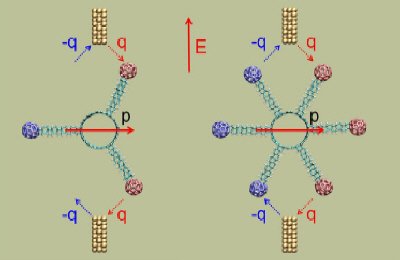
Researchers in the US have used computer simulations to show that nanometre-sized rotary motors could be driven by electron tunnelling. Although their design has not been confirmed experimentally, the team says that it is very similar to how naturally occurring biological motors work.
Sometime in the future, tiny autonomous “nanorobots” could be used to perform a wide range of tasks such as assembling electronic circuits or delivering drugs to specific parts of the body. But before this becomes a reality, nanotechnologists must come up with practical ways to propel such devices — something that has proven to be very difficult because conventional motors cannot simply be shrunk to nanometre dimensions.
Nature, however, contains a wide range of nanomotors — for example, some bacteria and other tiny organisms propel themselves using whip-like structures that are driven by biomolecular motors. Not surprisingly, researchers are looking at such “biomotors” for inspiration.
Powered by tunnelling electrons
The quantum-mechanical tunnelling of protons is believed to be at the heart of some biomotors, and now Petr Král and colleagues that the University of Illinois at Chicago have shown that electron tunnelling could be used to drive manmade nanomotors.(Phys. Rev. Lett. 101 186808).
The team used molecular-dynamics computer simulations to model nanomotors that comprise a carbon nanotube shaft with molecular “stalks” terminated by conducting “blades” (see figure). The rotor resembles a water wheel, except that one electron at a time tunnels between stationary electrodes and moving blades.
With each electron passing through the blades, the device rotates by either 120° or 60° — depending on how the blades are configured. Rotation occurs because the net effect of charging and discharging the blades nearest to the electrodes creates an electrode dipole moment across the rotor. This dipole is subject to the electric field created by the two oppositely-charged electrodes and the resulting torque drives the rotor.
Very similar to some biomotors
This mechanism is very similar to the way some biological motors work, Král told physicsworld.com. “Our motors take one electron after another — while biomotors take single protons — and rotate for each electron passing through.”
The team believes that such devices would be robust because single-atom defects present in all such small-scale devices would not affect the rotor mechanism — especially if they were fabricated in many parallel units, or “brushes”. They should also work at room temperature, which is crucial for real-world applications.
Most importantly, they could be used to drive nanoscale machines, such as molecular propellers. Once connected to such devices, they could pump liquids at the nanoscale, for instance, or manipulate and move other nanoscale systems.
These artificial systems would surpass their biological counterparts in many ways, adds Král. For one, they could rotate a million or more times faster. Moreover, these and future man-made systems might be combined with biomotors to make hybrid systems.
Král and colleagues have made several animations of how the motor would work.



